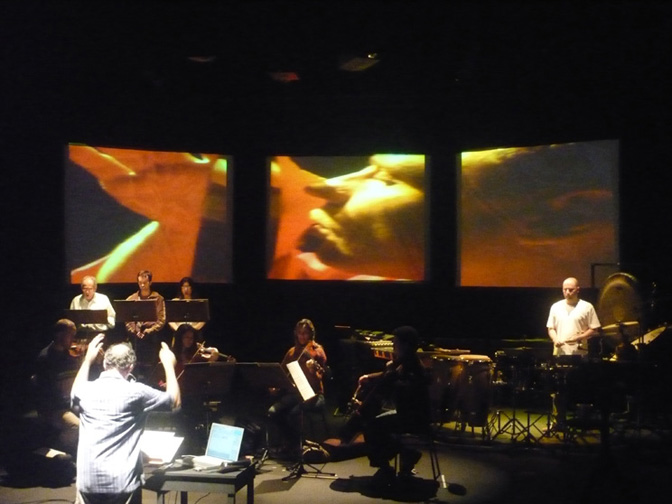

Paulo Chagas conducting Corpo, Carne e Espírito at Klauss Vianna Theatre, Oi Futuro, Belo Horizonte, Brasil, 2008. Yiorgos Bakalos on triptych screen, live visual compositions by Johannes Birringer. Music ensemble: left to right standing: Eládio Pérez-González, Sérgio Anders, Mônica Pedrosa, percussion (right): Sérgio Aluotto ; strring quartett (front): Frank Hammer, Eri Lou Nogueira, Cleusa Sana, Pedro Bielschowsky. Photo courtesy of Luca Forcucci.
The musical composition for Corpo, Carne e Espírito has a prehistory, as the music was first created for a live dance performance in Germany a few years back. I had been working on Bacon and had planned to compose a piece inspired by his pictures when I was asked to compose the music for Johan Kresnik's and Ivo's choreography "Francis Bacon". They contacted me one month before the premiere and everything went very very fast. I composed the whole music in practically two week while I was working in another project, an interactive piece with the visual artist Doris Villa, which was presented in Bonn at the same time as Francis Bacon in Stuttgart.
I saw a couple of rehearsals in Berlin and talked with Kresnik and the dancers. Kresnik didn't say too much. I tried to catch the atmosphere of the choreography by watching the dancers. Then I sent them a couple of musical excerpts made with the computer, and they gave me their feedback. Everything was done really very fast.
In my composition, I try to capture the poetic of Bacon's universe, the invisible forces behind the surface of bodies, the meanings that can be associated with Bacon's figures but are not necessarily related to the body. In this sense, my music builds a strong contrast to the choreography, which is very direct and full of stereotypes - which is typical of Kresnik's aesthetics. I think this extreme contrast between the (socialistic) realistic, concrete and objective dance and the subjective, abstract and poetic music was the key of the success of the piece, although in my opinion the reviews didn't account for the significant role of the music. This is typical in the dance world.
My music is very intuitive, as I didn't have much time to think about structure
and large forms. I use a very reduced harmonic material - based on a system
of intervals (a lot of major 7ths) and a repertoire of extend techniques for
string instruments. There are a lot of contrasts in the music, for example between
extremely soft, fragile sounds and very loud, noisy sounds. I use for example
the technique of pressing the bow against the string for producing scratching
sounds. In the music for voices, also I use this kind of contrast between modal
melodies and harmonies, that remember medieval and early renaissance polyphony,
and unusual sounds produced through or in combination with breath, whispering,
speaking, etc. An emblematic piece is "Pope"; in the fourth part of
the piece, the baritone sing a melody that could be a gregorian chant and he
switches to "weird" sounds. I use a very detailed phonetic notation
- combined with inhalation and exhalation - and the singers produce a lot a
noise by articulating specific combinations of consonants and vowels. I will
show an excerpt from the score of "Pope" where one can see how complicated
and detailed the notation is.
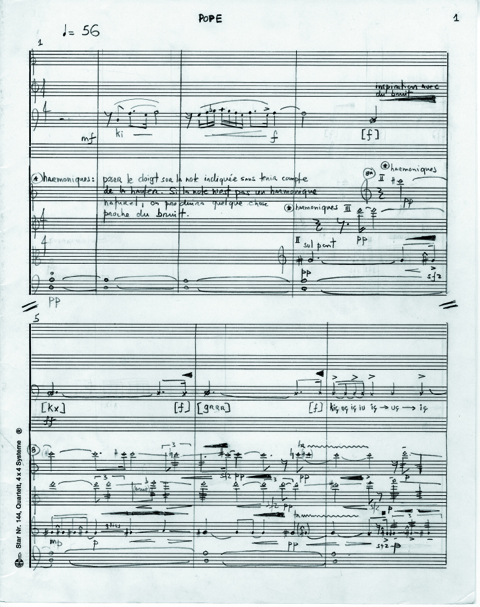
Also the contrast between string quartet and percussion contributes a lot to
produce meaning on the piece. There is kind of opposition between sophistication
and roughness through the whole music - which I think is related to Bacon's
aesthetics. Sophistication is expressed by the string quartet itself, by the
complexity of the polyphony, the richness of gestures, dynamics, timbers and
extended techniques. Roughness is expressed by the use of percussion creating
"beats", the many types of noise, the use of modality for melody and
harmony, the simplicity of some parts, the use of grotesque, etc.
I would say that the music of Corpo develops a pluralistic, semiotic
aesthetics that articulates different kinds of meanings based on very strong
and clear oppositions. It is similar to the phonetics in the language. The significant
opposition roughness/ sophistication is related to nature/culture, body/spirit,
perception/ communication and many other meaningful categories
Musical Sequence of Corpo, Carne e Espírito
PART 1
1. BIRTH
Electronic music 4'10"
2. PRISON
Electronic music 3'15"
3. MEN’S LOVE
Electronic music 4'55"
Entr’acte
Silent Mouth 1 / Scream / disease of the mouth 1:00. Old Man.
PART 2
4. KNIFE / VIOLATION
Soprano, countertenor, baritone, string quartet, percussion and electronic music
8'40"
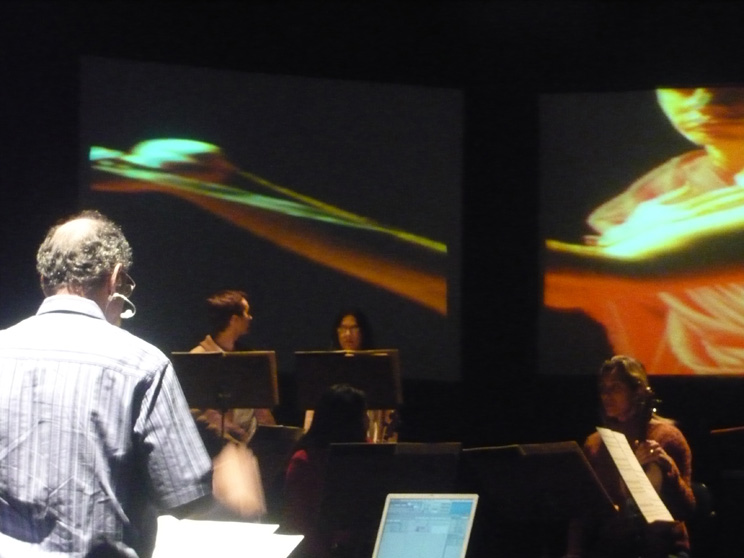
Paulo Chagas (left), in scene 4.
5. LONELY / TWO BODIES
Electronic music 3'03"
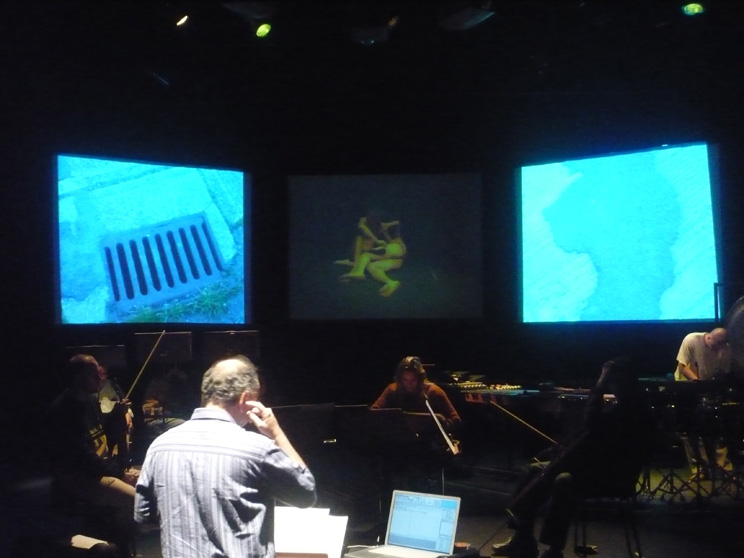
rehearsal for scene 5.
6. FILM
Electronic music 3'20"
Entr’acte
Silent Mouth 2 / Scream 1:00 Young Man.
PART 3
7. EMPTY SPACE
Countertenor, soprano, baritone 2’04“
This piece is in the style of English Baroque music (Purcell).
It creates a significant contrast with what all the music that has been heard
before. At the beginning, the countertenor sings a nice melody; towards the
end he speaks the phrase “for their sport”. After that I added “24”
of soprano and baritone with countertenor; it extends the music and build another
texture with three voices.
8. SHAVING
String quartet, percussion and electronic music. 4'55"
The string + electronic texture of this piece creates a interesting
contrast to the vocal texture of Empty Space. The music fades in from the silence;
the sound of the string quartet is mysterious. Percussion and electronic music
punctuates the texture. The music is static, it doesn’t go anywhere.
9. DANCE WITH BLANKET
Cello solo 3'14"
It starts as a clear and heavy dance and suddenly it brakes
in soft sounds; then it keeps alternating between the dance and the breaks as
if the dance is not allowed to continue. In the second part, the music changes.
Instead of the dance the violoncello plays dilacerating sounds, as if the dance
turned into something very anguished. At the end the dance returns as fragments
and fades out.
10. MEN’S LOVE BLANKET
Violin, viola, cello, percussion 3'20"
This piece plays with the difference between synchronization and not synchronization. At the beginning, the strings and percussion play together but in the third beat they start to deviate and separate themselves in different lines. Then it falls apart, than it returns together and so on. When the xylophone starts to play, the music becomes sharper. Than the strings play a pulse together and the bongos carry on with it. The music ascends to the high pitches afterwards it returns down in chromatic scales. At the end, the marimba plays a solo and the music finishes in a sort of suspension. It doesn’t really end.
Entr’acte
Silent Mouth 3/ Scream 1:00 Woman.
PART 4
11. LOVE
Soprano and electronic sounds 3’00“
Text: Francis Bacon
The electronic music starts very strong disclosing a large space.
The soprano sings only one word: love. The soprano starts to sing after 27”.
She sings only two notes in her low register; the interval of triton is quite
tense. Then she inhales and exhales with noise and returns to the melody. Then
she inhales and exhales twice, make a pause and starts again the same melody,
but this time she keeps moving on. The melody rises. Another pause, than she
repeats the melodic fragment after and makes a microtonal glissando. Then interval
of triton of the beginning becomes a sort of appoggiatura leading to the high-sustained
pitch.
Summary: the soprano attempts to build a beautiful and generous melody, but
it is continuously broken by breath, pauses and disruptions.
12. POPE
Soprano, countertenor, baritone,
string quartet and percussion 4'04"
This piece represents the essence of the whole music. Here we
have two different worlds: a “medieval” world represented by modal
melody and harmony; a “noisy” world represented by strange phonemes
(consonants), extended techniques on the string instruments, effects on the
strings and percussion. Everything is fragmented and pushed to the limit of
possible. Nothing stays; there is a constant transformation of the material
trying to develop something but it doesn’t go anywhere.
13. GEORGE DYER
Violin solo 3'00“
Here also there is a constant opposition between soft and loud sounds. We find the same kind of dialectic from Love and Pope but in a different scale. There is a tension on the very beginning and a will to establish a more comfortable and pleasant atmosphere; but it doesn’t really succeed.
14. DISTORTION / SELF-PORTRAIT
String quartet and percussion 4’50“"
I added two new parts to this piece: first part (new) is called
“Male Love”; it is a strong and loud solo of percussion with many
instruments (0’47”); second part is “Distortion” (1:36”);
third part (new) is called “Death”; it is a bass drum solo alternating
very soft and very loud sounds (0’42”); fourth part is “Self-Portrait”
(1’36”). This is a very dissonant piece, maybe the strangest piece
in the whole piece. The two new parts create a distance and a dramatic structure
opposing solo and ensemble – or individuality and destiny. I think this
piece is about the individual facing love, death, anguish, anger, despair, solitude,
etc.
Entr’acte
Silent Mouth 4 / Scream 1:00 Young Man/Old Man
PART 5
15. SCOTCH TAPE
Soprano, countertenor, baritone and electronic sounds 2’30“
Text: T. S. Eliot
The piece has two opposed layers. The singers sing (text: “Who is the third”) a pleasant three parts motet that sometimes remembers the musical style of the Renaissance. Some harmonies are beautiful. On the background, we hear voices of screaming, crying, etc. This is the third. It is the invisible part of the individual, the body, the feelings that come out, the sensations, etc.
16. HANDICAPPED I
Soprano, countertenor and baritone 3’06“
Text: T. S. Eliot
This piece has also three voices (as Scotch Tape) but without electronic. At the beginning, the countertenor whisper, “My nerves are bad tonight”. The music alternates between singing and speaking and also between short solo fragments and homophonic passages where the three voices sing the same rhythm.
17. HANDICAPPED 2
String quartet and percussion 3'20
This is a quiet nice piece. At the beginning the violin 2, viola and cello play together a fast pulsing texture and the violin 1 plays a melody. Then the cello plays a second melody and the whole move towards the high pitches becoming dramatic. It follows a break. The violin 1 plays a delicate melody with very high pitches (flautando); afterwards, there is a counterpoint with different kinds of textures. On the third part, all the instruments play together but the tempo and rhythm changes constantly. Than an interruption for the solo of the violin 1 and the final chord with all the instruments; at the very end the percussion play just a crotale (high metal instrument) that resonates above the strings
18. HANDICAPPED 3
Soprano, countertenor, baritone, string quartet and percussion 2’40“
Text: Francis Bacon
Handicapped 3 three uses the same material than Handicapped 2 but it adds the voices and percussion. The piece starts with the tam-tam playing short metallic pulses. The tam-tam attacks resonate with the strings. This idea is repeated a couple of times; then the voices entry one after the other. The percussion switches to the vibraphone; the music achieves a climax with voices, strings and percussion and suddenly cuts off letting resonate only the vibraphone. Handicapped 3 is maybe the most consonant piece. It creates a sort of euphoric mood, although the text says “I think about death every day”.
Total time: 72:28 min
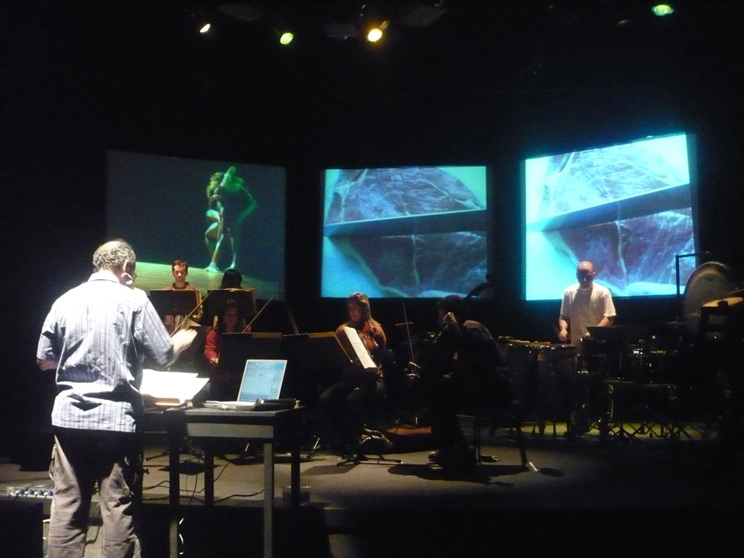
rehearsal for scene 4
Remarks about the musical structure
I changed the order of part 5 and 4. I think it works much better in this way.
This is how I analyze the structure:
Part 1: Three electronic pieces create a strong atmosphere. It starts slow und
gets faster. It builds a directional structure.
Part 2: Starts with live-music and a very strong piece (Knife / Violation) followed
by a soft electronic piece (ambiance) and a virtuoso percussion solo piece.
Part 3: Alternates a solo piece, ensemble, another solo and another ensemble.
Each piece has a different style and atmosphere.
Part 4: The same structure as before: solo, ensemble, solo and ensemble. But
there is a sense of continuity. There is also a movement toward more dissonance.
Love is consonant, Pope alternates consonant and dissonant, George Dyer does
the same in a small scale and Distortion / Self-Portrait alternates solo, ensemble,
solo and ensemble. This is very interesting. We have here a recursive and fractal
structure developing contrasts inside contrasts.
Part 5: Here we have a directional structure in many senses: from voices alone
to voices with string quartet and percussion; from a dissonant mood to a consonant
mood. We have also a development of the same material.
The structure can be summarized as following:
1. Directionality from slow to fast – electronic sounds; opening of space
2. Opposition between live-performance / electronic and large ensemble / solo;
alternation of spaces
3. Alternation between solo / ensemble; different characters and atmospheres
4. Alternation between solo / ensemble and consonance / dissonance; dissonant
mood
5. Directionality from voice to ensemble; sense of development; consonant mood.
Entre’acte
I don’t think it is necessary to have music in the entre’acte, naturally.
It is better to have the silence with the visuals of mouths and whatever gesture
we ask the singers to create. Silence will create much more expectation than
music. Also the first piece after each entre’acte starts with voice, so
we can easily build a continuous between the visuals of the entre’acte
and the following piece. For example, in Part 3 the two other singers could
keep acting while the countertenor sings the solo. The same in Part 5 when the
soprano sings. The question of a visual staging (acting) is complex, in regard
to the idea of the oratorio and the formal concert (singing from score, playing
from score) in conjunction with the live digital processing of the body images.
________
Texte und Kommentare zum Labor 2008 werden hier veröffentlicht
Texts and commentaries on the 2008 lab and related research subjects will be published here.